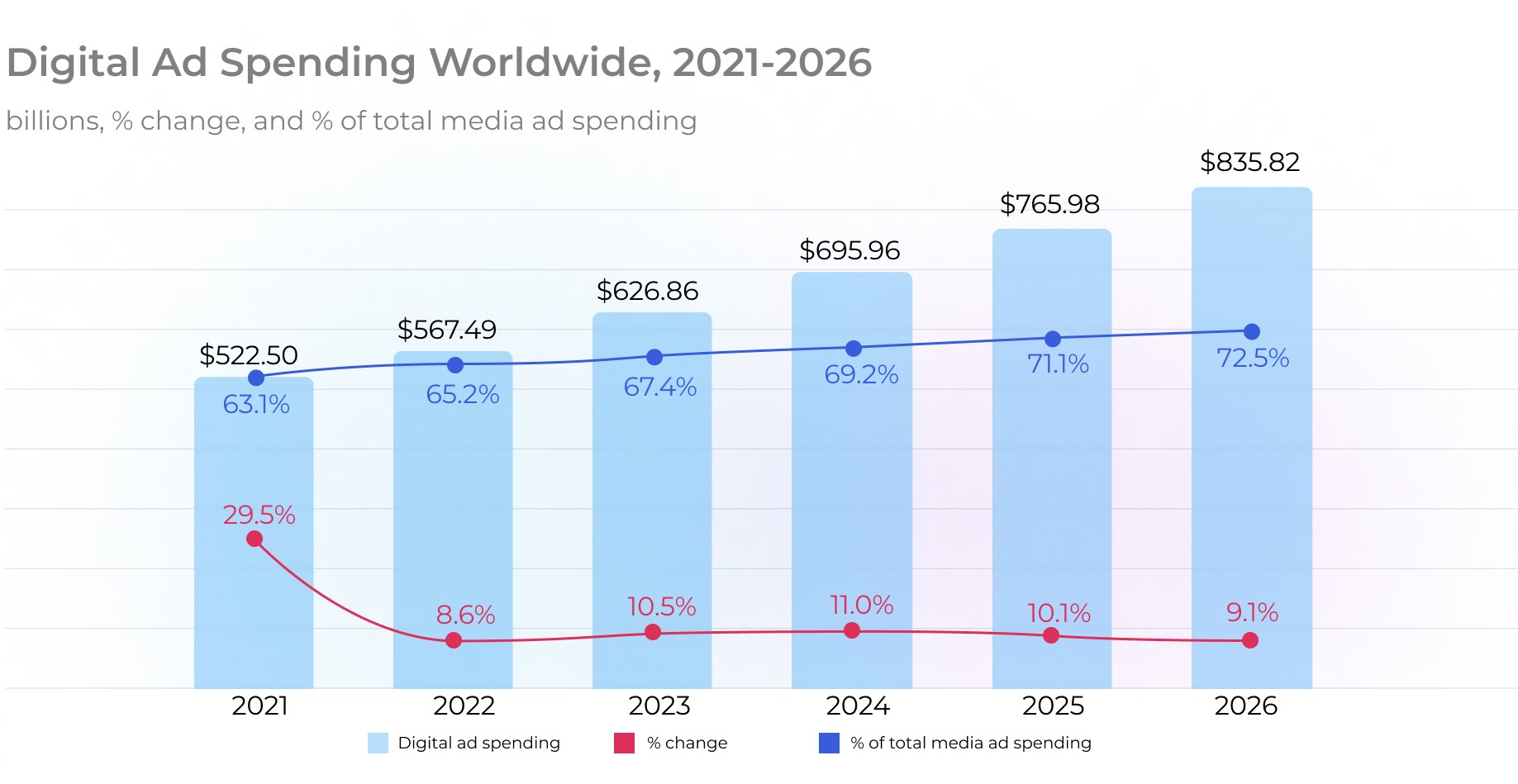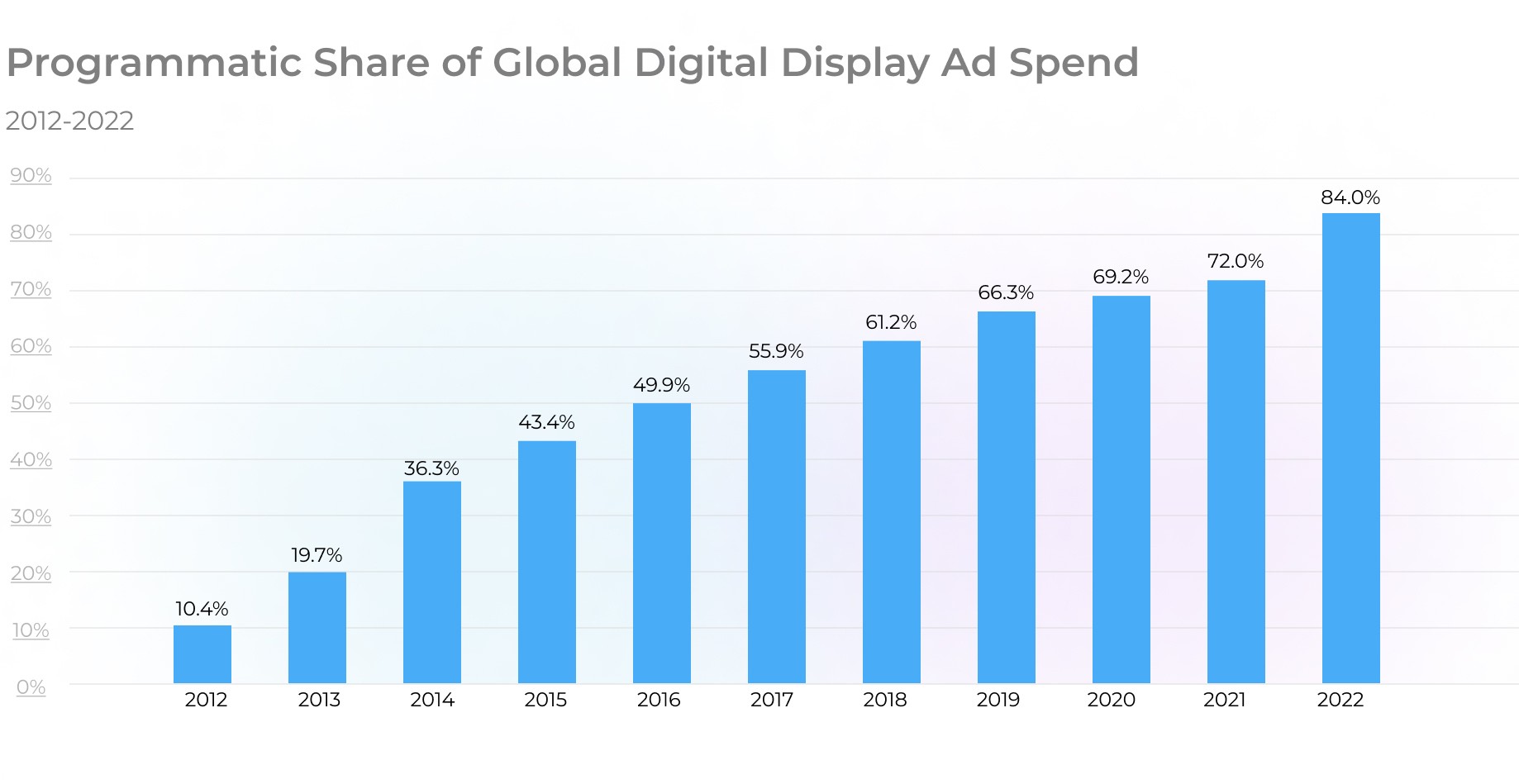To spend or not to spend on digital ads?
It was not long ago that Google sent shockwaves across the entire advertising industry by making a move to block third-party cookies from Chrome, the most popular browser in the world. Fearing that the adtech sector would crumble, many investors pulled away.
But recent adtech mergers and acquisitions paint a far more optimistic picture. Last year, deal volume among adtech and martech companies rose a whopping 82% year-on-year. If anything, this growth means that businesses are excited about a new chapter of efficient, brand-safe digital advertising.
And data-driven analytics is exactly what helps adtech solutions deliver on that promise. Given the unprecedented volume of data that the advertising industry deals with, advanced analytics enable publishers, advertisers, and marketers to make informed business decisions, improve ad inventory efficiency, create personalized campaigns, all while staying on top of ad spend.
Ad spending in numbers: today’s picture
Management guru Peter Drucker is often quoted as saying “You can’t improve what you don’t measure”.
What’s going on with digital advertising spending worldwide? In a nutshell, billions of dollars spent on digital ads globally are steadily growing, which demonstates overall business readiness to invest in this channel.

Source: eMarketer
But how to invest wisely to reap the benefits of advertising instead of kicking yourself for wasted money? Let’s unveil all powers of data-driven analytics that’s making each and every ad-related step super conscious.
Programmatic advertising and AdTech software vendors involved
Programmatic advertising is at the core of the adtech industry. It refers to the use of technology to automate the process of buying and selling advertising space as opposed to manual processes that relied on negotiations, insertion orders, and requests for proposals.
Back in 2012, the share of programmatic advertising was slightly above 10%. Last year, 84% of global digital ad spending was transacted programmactically, and the number continues to climb up. Specifically, the share is predicted to grow up to 87% by 2026.

Source: Marketing Charts, Statista
Programmatic advertising ecosystem consists of many components: demand-side platforms (DSP), supply-side platforms (SSP), ad networks, ad exchanges, private marketplaces, data management platforms (DMP). These solutions rely heavily on data analytics to support better, more efficient digital advertising:
- SSPs use data-driven analytics to define price floors based on historical data.
- DSPs leverage analytics to forecast impression bids.
- DMPs rely on machine learning algorithms to analyze first-, second-, and third-party user data and enable in-depth insights into audience behavior.
- Ad networks utilize sophisticated, ML-powered real-time bidding (RTB) models to help advertisers get the most conversion value.
The diversity of the programmatic ad ecosystem inevitably causes the number of challenges behind. Namely, DSP providers are seeking less isolation, trying to get integrated with other marketing tools for winning more efficient results in advertising. A separate milestone to unlock is driving an ad’s targeted reach — maintaining the addressability of advertising comes crucial for generating a competitive service offering.
Tech and operational challenges seem no less relevant — the delay in delivering new features, which blocks outperforming other ad software vendors, countering data losses during data transfer to DMPs/DSPs, insufficient use of ML tools or deep learning algorithms to achieve better targeting constitute a tiny part of the complete set of obstacles.
Case in point: how we refined a demand-side platform for digital marketing
One of Oxagile’s project cases vividly illustrates what we’ve just talked about — when a DSP provider admitted a fact that an obsolete tech stack coupled with a solution’s architectural constaints didn’t let them steadily grow their client base, our team put hand to DSP platform reengineering to open up new dimensions of a DSP’s scalability potential.
There were also vital UI tunes we couldn’t afford to stand back — a newly delivered user interface made the solution more attractive for end users, while turning tricky workflows into a really “easy-peasy” process.

Marketing agencies and top-ranking brands: what bothers them on their way?
Ad performance measurement
Since the advertising ecosystem has become very segmented — think social, search, direct, programmatic, connected TV, and more — the challenge is to effectively track these multiple environments. While brands intend to easily acquire consolidated analytics on media performance and ROI on ad efforts, all kept in one place, marketing agencies consider unified measurement as a means to offer their clients a more attractive service through meaningful, easy-to-interpret reports on advertising performance.
The former rely on marketing mix modeling, which enables more effective budget allocation through switching between marketing campaigns, channels, and DSPs.
The latter often look in the direction of ad quality solutions, aiming to:
- Achieve accurate ad performance metrics, taking into account both first- and third-party data.
- Pose no risk to brand safety.
- Leverage anti-fraud solutions to protect each and every step of an ad campaign.
Integrating autonomous systems into one unified solution to get an all-embracing picture of advertising campaigns efficiency is no longer a poser — adtech analytics tools bring disparate sources of data under one roof and enable marketers to track relevant advertising metrics and KPIs from a single dashboard.
Armed with the holistic view of their marketing efforts across platforms and channels, businesses can improve ad performance and maximize reach, while reducing operational pains.
What are your adtech challenges?
Leverage our multi-year adtech expertise and machine learning know-hows to build a tailored adtech solution that solves your unique business needs, whether it is automated ad buying, efficient ad inventory management, granular audience segmentation, or any other challenge.
Intelligent audience targeting
No matter how much you have invested in your ad campaign, it will bring results only when shown to consumers who are most likely interested in your product, i.e. your target audience. To deliver more tailored and personalized messages, you can utilize data analytics for online advertising to further segment your target audience into subgroups based on shared characteristics like demographics, location, online behavior, interests, and more.
But in-depth audience insights is not all that advanced adtech analytics can provide. By leveraging computer vision and machine learning capabilities, adtech solutions can accurately identify context and enable smarter contextual targeting. AI and ML also drive the process of dynamic content optimization — delivering the right message to the right audience by the data-based adaptation of creatives to specific audience segments.

Transforming routine processing into automation
This is mainly about uncoordinated ad processing — marketers might face tiresome operations, while managing ad campaings or customizing settings through several points of entrance and diverse data sources, including demand-side platforms and social platforms. They’re seeking out the ways to optimize hours-long processing, the solution to which is closer and easier they sometimes think. Our project case sample will serve as a proof for it.
Case in point: aggregation tool born to pool the efforts of a few DSPs for shining ad campaigns
Dealing with a couple of DSPs proved to be not an easy task for a marketing agency that tried to get the most out of each. Instead, they highlighted certain processing gaps, reporting issues accompanied by slow analytical data collection processes, and some missing functionality, even despite a handful of demand-side platforms utilized.
A DSP orchestrator delivered by Oxagile’s team helped the client get the best of two worlds — on top of acquiring a unified UI for instant ad campaign configuration and analysis, they now offer a DSP aggregation tool to their customers as a SAAS solution.

Ad yield optimization as a number one goal for content owners and distributors
In digital advertising, ad yield refers to the revenue that publishers get from selling advertising inventory. To maximize revenue, they need to sell at best prices based on market demand.
Although this concept seems rather simple, managing ad inventory is not — publishers today are juggling multiple ad exchanges, ad networks, individual advertisers, and media companies.
Also, ad yield optimization is much more subtle than selling every bit of inventory at the maximum price. This is a variable pricing strategy that aims to take into account both short-term and long-term implications.
Yield optimization is the effort to maximize the value of advertising by delivering the right inventory at the right time to the right viewer.
Big data analytics can help publishers optimize pricing on programmatic markets in real time. With the ability to analyze millions of data points like competitors’ pricing, user’s location, time of day, the device type, etc., machine learning-powered adtech solutions help publishers predict the buyer’s willingness to pay for an ad impression and then dynamically adjust the price. This yields significant profit margin improvements for publishers, as they’re moving to more consistent processing.
What are pertinent techniques for better content monetization?
- Managing digital and linear ad space convergently — to gain a competitive edge in ad sales.
- Integration tools that allow managing inventory across different types of platforms, covering both traditional TV and digital channels.
- Moving towards multi-dimensional monetization models, fostering the consumption of a free ad-supported TV (FAST) and advertising-based video on demand (AVOD) experience.
- Ad analytics to generate ad packages across all advertising channels and assets.
- Ad analytics in a single solution to better understand which assets and partners stimulate the biggest revenue generation.

FAST’s becoming a trend. Source: PR Newswire
Case in point: big data-driven online video monitoring solution to fine-tune monetization strategies
When an OTT TV platform owner asked Oxagile about possible methods to better drive their content monetization and acquisition strategies, we already had an answer in mind.
An OTT platform monitoring solution able to process both historical and real-time statistics for a holistic analysis of user behavior facilitated the creation of targeted recommendations and made a direct hit with the ads perfectly matching specific demands or interests.
How has the solution affected the company’s ad revenues? Among the latest figures attained is a 58% CTR boost powered by micro-segmented ad campaigns.

The bottom line
After the pandemic-induced recession and budget cuts, the advertising industry is finally making a major comeback. 2021 already saw record ad spendings, according to industry leaders. Global Ad Forecast introduced by MAGNA predicts media owners’ ad revenues have all chances to reach US$833 billion in 2023.
To improve return on ad spend, businesses need scalable adtech analytics solutions that can handle vast amounts of complex data, learn patterns for different KPIs, and deliver actionable insights and data-driven predictions.




























